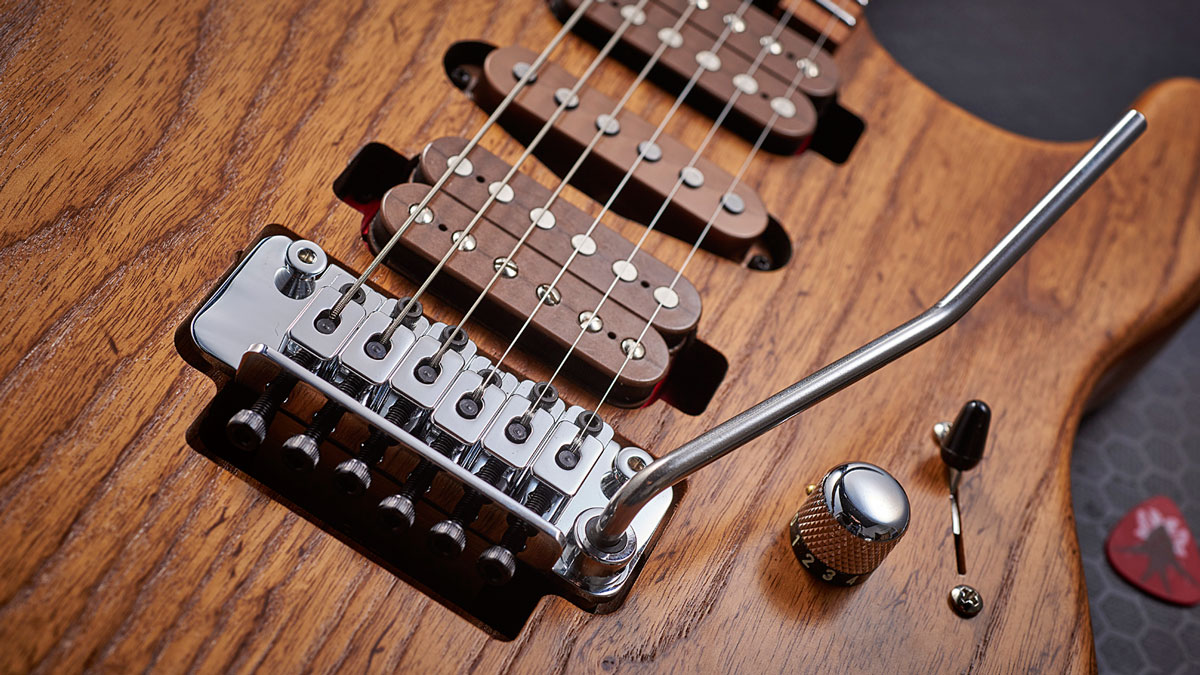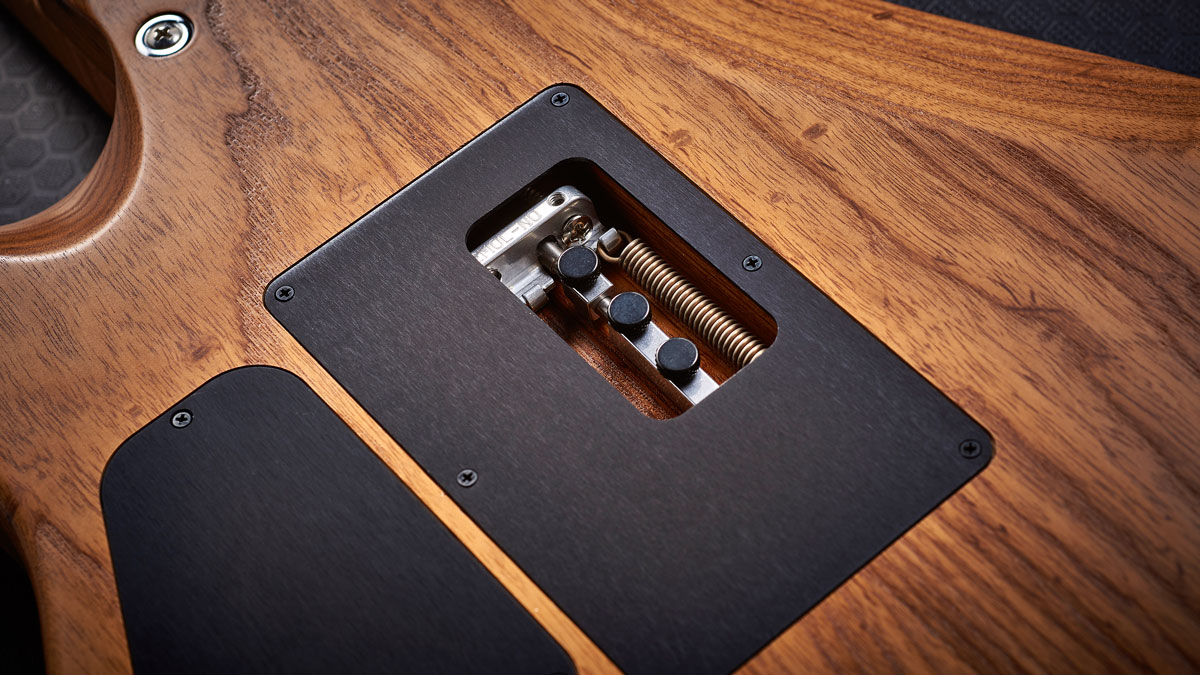MusicRadar Verdict
It’s not a cheap date but it’s an astonishing guitar: a player’s tool of the highest calibre.
Pros
- +
Everything!
- +
From the wood choice through to the fine details, it’s superbly considered.
Cons
- -
It’s pricey.
- -
There are no colour options or lefties: what you see is what you get.
MusicRadar's got your back
Part of the Fender empire since 2002, Charvel’s reputation was founded by making custom guitars for great players.
It’s currently signature home to Warren DeMartini, Joe Duplantier, Jake E. Lee and our own Guthrie Govan, who’s first signature model appeared in 2014 after two years of development. Earlier this year two Charvel Guthrie Govan Signature models were announced with virtually identical features and price, the difference lying primarily in their woods.
It means the full title of our reviewed model is the, deep breath, Charvel Guthrie Govan Signature HSH, Caramelized Ash, Caramelized Flame Maple Fingerboard, Natural - the other being the Charvel Guthrie Govan Signature HSH Flame Maple, Caramelized Flame Maple Fingerboard, Natural. Bonkers.
But name length aside there’s nothing bonkers about the guitars: our caramelized ash body model is up there with the finest bolt-ons we’ve ever played. How so? Unlike the basswood/flame maple top version, the construction here is intended to have a bit more character, at least tonally.
The body is two-piece, centred joined ‘caramelized’ ash (yet another word for torrefied timber), which with its thin lacquer finish shows off the bold wavy-striped grain. It doesn’t appear to be grain filled and is hugely textured.
The similarly caramelized maple neck has a bold striped figure on the back that’s only slightly milder on the separate fingerboard. It certainly adopts a thin depth flat ‘C’ and if the spec sheet didn’t tell is it was coated with a hand-rubbed urethane gel we’d suspect it was oiled.
Under that fingerboard, however, are dual graphite rods - to increase stability - and, of course, there’s a two-way adjustable truss rod with body-end wheel adjustment. The fingerboard face has a compound radius, 24 big stainless steel frets and clear contrasting position dots and Luminlay luminous side dots.

The neck is extremely tight-fitting and held in place with four screws, each recessed into the contoured heel. The bridge, initially, looks like an early Floyd Rose (without fine tuners) but is a USA-made Charvel design that centres around a thick brass inertia block, steel top plate and large saddles into which the strings are locked via those long Allen key bolts; once intonation is set each saddle is firmly locked in place. It’s back routed too and the whole unit is recessed into the body so the top of the bridge plate is flush with the top of the body.
A Tremol-No is fitted so you can prevent upbend, lock it in place as a fixed bridge or, as supplied, just use it as a free floating vibrato with a huge range from floppy to an upbend of approximately a fourth on the G string (it’ll go a bit higher but we stopped there).
Perhaps surprisingly a typical locking nut is replaced with a classic bone nut and Sperzel locking tuner,yet even straight out of the case the tuning stability was hugely impressive, not least with that wide range. Even the stainless steel arm has been ‘tuned’: it’s a tight push fit into a plastic collar (with tension adjustment) but with zero free play.
Matching the caramel colour are the centre single coil’s cover and bobbin tops of the uncovered neck and bridge humbuckers - which are firmed screwed to the body with no intended height adjustment; the middle single coil has a little more movement but not by much.
Like any HSH set up you have huge choice on exactly how you wire it - this is no different. While the outer positions select the full humbuckers, position two voices bridge (slug single coil only) and the middle single coil; position three gives us bridge and neck (both slug single coils); position four offers the screw single coil of the neck pickup with the middle pickup.
There’s no provision for voicing the solo middle single coil, or any way of coil-splitting the two humbuckers but via a ‘secret’ two-way mini toggle that is simulated by an old-school passive filter (a 0.1 microfarad capacitor). Internally the circuit features EVH 500k pots, and cap/resistor in parallel on the volume control.
The guitar is full of subtle details. Along with those luminous side dots we also get dome-topped Luminlay control knobs with clear luminous numbers around each base. A Strat-like dished output jack is placed close to the base strap button so plugging in and threading your lead through your strap is really easy. Even the strap buttons seem over-sized.
Sounds
In many ways this feels more like high performance rifle, not a guitar. It gives off a tuned-to-perfection vibe that’s like an instrument you’ve owned for a while, gigged, modified and tweaked. Which in reality is exactly what it is only Charvel and Guthrie Govan have done it for us.
The big surprise here is the neck which, certainly in Fender terms, feels skinny with a depth at the 1st fret of 19.9mm and 21.1mm at the 12th. Yet it has a very comfortable, flattened ‘C’ profile with nicely rolled fingerboard edges that is hard not to like. No, it doesn’t feel like a big necked old-style Fender but it’s great for thumb around left-hand styles unlike some modern shapes which seem overly flat-backed.
The big frets (approximately 2.79mm wide x 1.3mm high) keep the strings (and your fingertips) just off the face of the fingerboard and make for superbly slippery bends. It feels like its strung with .010s and has plenty of fight. The compound radius is far from vintage but just doesn’t fret out anywhere - it just lets you play, effortlessly.

For someone like Guthrie there’s plenty of money up the dusty end and the tapered heel and rear contour on the back of the treble cutaway allow effortless access if you need. How you drive it, of course, is up to you.
But don’t dismiss this as a virtuoso rock shredder axe. Yes, if your technique is up to it, you won’t have a problem there and using just the bridge pickup you’ll probably have all you need: big and ballsy, a hint of a cocked wah-like high end it’s certainly in the JB area. But it’s offset by a pokey PAF-like neck voice, tube-y and soupy but far from one dimensional. If that was it, we’d be smiling. But there’s plenty more...
The ‘single coil’ switch barely drops any volume and gives a subtle but sonically significant Fender-esque texture that moves the guitar into a different space and style and with some light crunch fits right into that powered Stones-y raunch, especially if you pull back the volume.
Position two, and especially four, certainly suggest a Strat, position two being a little more steely perhaps that again loves clean-boosted crunch. It holds up well to other Strats we had to hand but none matched this one’s playability, string-to-string balance or indeed even response right across the board.
But we’re not done yet. Switch to a clean Fender amp, knock the edge off the tone and the neck pickup does a more than usable jazz box. Switch back to position two and there’s pedal-steel like sheen. Clean, crunchy or gained we couldn’t find an unusable sound; throw in the effortless playability and really wide stylistic voice and this is a real blues-to-rock-to-metal to wherever you want to take it journeyman guitar that is so hard to put down. We’re completely absorbed.
Guthrie Govan’s vision for an all round workhouse that’ll stand up to the rigours of professional touring is superbly realised in this signature. Every detail is wonderfully considered: the over-sized strap buttons, the Strat-like dished output jack placement, the hugely intuitive drive, that secret ‘single coil’ switch, the impressive tuning stability (and startling range) of the vibrato, not to mention the wood choice, graphite reinforced neck and a really unposh working player’s vibe.
Is there anything Guthrie hasn’t considered? Well, at £3k, a Fender style bolt-on in far from classic livery won’t wash with everyone. There are certainly other top makers out there that would at least allow you a choice of finishes with a similar specification at similar or lower prices - Vigier, for example, springs to mind. So, no, it’s not a cheap date but it’s an astonishing guitar: a player’s tool of the highest calibre.
Dave Burrluck is one of the world’s most experienced guitar journalists, who started writing back in the '80s for International Musician and Recording World, co-founded The Guitar Magazine and has been the Gear Reviews Editor of Guitarist magazine for the past two decades. Along the way, Dave has been the sole author of The PRS Guitar Book and The Player's Guide to Guitar Maintenance as well as contributing to numerous other books on the electric guitar. Dave is an active gigging and recording musician and still finds time to make, repair and mod guitars, not least for Guitarist’s The Mod Squad.
With its latest free update, Ableton has finally turned Note into the app I always wanted it to be
Technically capable, but struggle to make your tunes sound musical? 5 simple music theory hacks to make your tracks stand out
"Despite its size, it delivers impressive audio quality and premium functions as well as featuring a good selection of inspired sounds": Roland GO:Piano 88PX review











